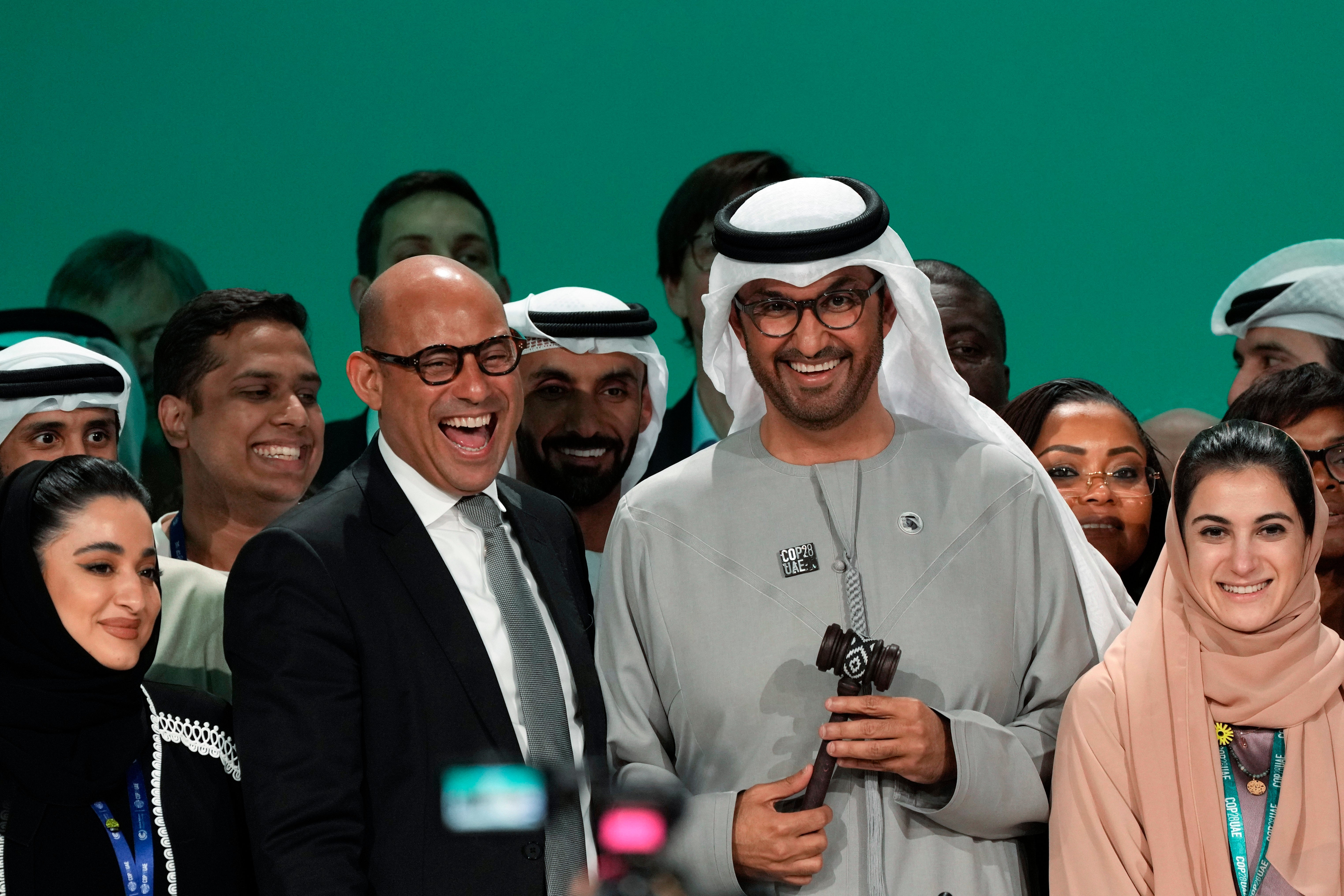Onwards from Cop28: Why nature must be at the heart of climate decision making
With the historic climate summit at a close, Lord Zac Goldsmith and CEO of Conservation International M. Sanjayan explain why restoring nature is the best thing we can do to ensure the safety and prosperity of our world


The question marks surrounding the start of Cop28 hung almost visibly in the hot, humid air.
Would world leaders agree to create a loss and damage fund, phase out fossil fuels, and boost renewable energy? Would nature finally be recognised as our greatest ally in reducing climate impacts, and would ending deforestation and scaling nature-based solutions feature in key agreements on adaptation and mitigation?
Under intense scrutiny from around the world, Cop28 took a topsy-turvy path of delivering for us one moment, but not the next. On the opening day, world leaders announced a long-awaited loss and damage fund to finance nations most affected by floods, droughts, storms and heat; but then announced commitments orders of a magnitude below what is required.
We saw 118 countries pledge to triple global renewable energy capacity by 2030; but, then, big energy companies signalled they will continue to drag their feet. And finally, we saw the world unite around an agreement to “transition away” from, rather than “phase out” fossil fuels – a historic measure but one lacking the clarity and ambition needed to set us on a definitive path to drive down emissions.
Now that it is over, what should we make of Cop28? And where do we go from here to tackle climate change, restore nature, and support nature-positive economic prosperity in the global north and south?
Nature is our greatest, most cost-effective tool for reducing climate impacts. Protecting, managing and restoring ecosystems can provide at least 30 per cent of required climate mitigation. Allowing existing trees to grow old in healthy ecosystems while restoring degraded areas, for example, could sequester 226 gigatonnes of carbon – equivalent to nearly 50 years of US emissions for 2022. In short, there is no pathway to net zero, no solution to climate change that doesn’t involve massive efforts to protect and restore the natural world.
So it’s vital that efforts to transition away from coal, oil and gas occur alongside ambitious and urgent action on nature, too. At Cop28, world leaders increasingly recognised the interdependence between our planet’s climate and biodiversity, with both the Cop28 and Cop15 presidencies, along with over 15 countries (including Brazil, Senegal, Colombia, the UK and the US), committing to greater alignment in the planning and implementation of national climate, biodiversity and land restoration plans and strategies.
Many will remember the historic Cop26 commitment in Glasgow, when 145 world leaders committed to halt and reverse forest loss and land degradation by 2030.
At Cop28, governments showed us how they are working towards this target. French president Emmanuel Macron announced three forest finance packages, including $100m for Papua New Guinea, $60m for Democratic Republic of Congo and $50m for the Republic of Congo. Siaosi ‘Ofakivahafolau Sovaleni, PM of Tonga, announced $100m to help Pacific Small Island Developing States protect 30 per cent of their waters and exclusive economic zones by 2030 – this single initiative involving almost all the Pacific island states represents the biggest conservation measure the world has ever seen. Ghanaian president Nana Akufo-Addo announced more than $80m to scale high-integrity carbon markets, sustainable agriculture and mining, and nature-positive timber and restoration.
Additionally, the World Bank promised to increase its spend on climate-related projects to 45 per cent of its annual financing, multilateral development banks united around an agenda to address climate, nature, and pollution together; and Costa Rica and Ghana became the first forest countries to agree to sell forest carbon credits through the public-private LEAF Coalition, potentially unlocking more than $60m for conservation and sustainable livelihoods.
But will these new funds and financial solutions be enough?
The latest science suggests that we will likely exceed 1.5C of planetary warming, and we are on the verge of crossing catastrophic climate tipping points that will unleash sweeping damage to people and nature. Global carbon dioxide emissions from burning coal, oil and gas have reached a new record this year and will continue to rise in the coming years.
At the same time, far more money is still flowing to activities that harm our world than those that support it. Banks continue to pump hundreds of billions into companies linked to tropical deforestation; 75 per cent of financial institutions do not have a public deforestation policy; meanwhile, the global deforestation rate stands at 15 football fields per minute. Environmentally harmful subsidies are estimated at $1.7 trillion, and private finance flows with a direct negative impact on nature at $5 trillion.
As things stand, current financial flows to nature-based solutions stand at $200bn, only a third of levels needed to reach climate, biodiversity and land degradation targets by 2030 – even though scaling-up nature-positive business models is estimated to represent a $10 trillion business opportunity.
It’s easy to see that progress remains miles off the mark – and that nature remains undervalued, underfunded and underutilised as a climate mitigation and adaptation solution.
As leaders return home from the UAE, what do they need to prioritise? We suggest four vital actions to build on the momentum from Cop28 and accelerate progress in 2024.
Place nature at the heart of climate decision-making. Set strong NDCs, prioritise eliminating destructive finance, and enact legislation and mandatory disclosure to end the financing of deforestation and direct capital to nature-based solutions.
Align public and private finance flows so that they no longer harm ecosystems and instead protect, manage and restore nature and mitigate against climate change. Close the investment gap, and work towards ensuring that annual investment in nature-based solutions – such as reforestation, seagrass and peatland restoration – almost triples to reach $542bn by 2030.
Ensure that indigenous peoples and local communities have a leading role in the operationalisation of all existing – and new – climate and nature-related commitments and action. Currently, indigenous peoples and local communities receive less than 1 per cent of biodiversity and climate finance, yet they are the guardians of more than 80 per cent of the world’s biodiversity. This makes no sense at all.
Transform agriculture and food systems by repurposing harmful subsidies and creating new incentives that encourage regenerative industry. This must include scaling up transitional finance for smallholder farmers and other frontline communities.
Although there is still so much to be done, by embedding these four important actions in their post-Cop28 planning, leaders can and will make a tangible difference.
And there is reason to be hopeful. Indonesia has seen declining deforestation for three years and is now at an all-time low. In Brazil’s Amazon, deforestation dropped by over 30 per cent during the first six months of president Luiz Inácio Lula da Silva’s term, highlighting the crucial role of national governments in halting the destruction of vital ecosystems. We need this trend to continue and escalate – world leaders working together to safeguard our planet, so that humans and all life on Earth can thrive.
Lord Zac Goldsmith is a former minister of state for overseas territories, Commonwealth, energy, climate and environment. M. Sanjayan is the CEO of Conservation International






Join our commenting forum
Join thought-provoking conversations, follow other Independent readers and see their replies
Comments